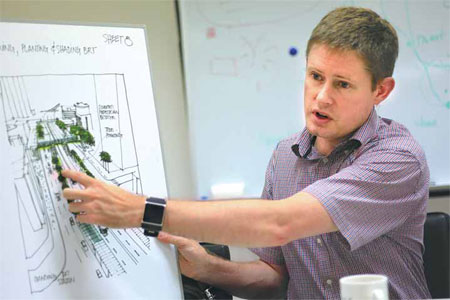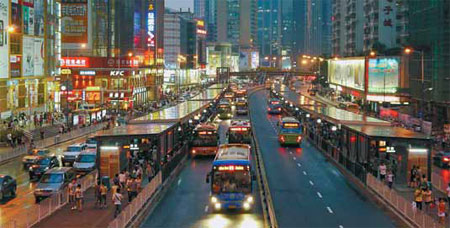Fast lane in Guangzhou
Updated: 2012-09-18 07:58
By Xu Jingxi (China Daily)
|
||||||||
|
Karl Fjellstrom displays his design sketch of Guangzhou's Bus Rapid Transit system. Photos by Zou Zhongpin / China Daily |
|
Guanghzou's BRT helps 800,000 people travel daily. |
He is happiest looking at traffic as it hums smoothly along a major thoroughfare in Guangzhou, Guangdong province. Xu Jingxi talks to the man responsible for helping cure congestion in the city.
It used to be a nightmare taking a bus across Gangding, a downtown area full of IT malls, office blocks and hotels in the Tianhe district in Guangzhou. Buses fought against cars coming out of parking lots just to approach their bus stops. They would edge along the road caught in the lines of cars traveling at a snail's pace in the gridlock.
Guangzhou, capital of Guangdong province, is one of the fastest growing cities in China. Like other major metropolises in the world, it was plagued by traffic gridlock, but unlike some other cities, it seems to have found a solution. The key is the city's Bus Rapid Transit (BRT) system.
The first BRT line opened in February 2010, along Zhongshan Avenue in Gangding, where the central lanes have become dedicated bus lanes, and BRT stops have been moved from the side to the middle of the avenue.
Now BRT buses whiz along the bus lanes, partly clearing the way for cars along the sides, which are also moving at a more efficient speed with the orderly flow of traffic.
Karl Fjellstrom is the lead expert on Guangzhou's BRT. The 40-year-old Australian expert on public transport planning was invited to Guangzhou in late 2004 to design the city's first BRT line. It was a tough start.
"People were worried because Guangzhou's BRT is a big project with many innovative designs. They did not understand that a bus is justified in having priority on the roads because it carries more people than a car. A city's transportation planning should be people-oriented rather than car-oriented," he says.
"I knew the BRT would succeed, and if anybody asked me, I told them it would be a big success. Time would tell."
It did, and the BRT now helps 800,000 people travel better daily.
Fjellstrom's confidence in the project was based on his team's rigorous design, supported by a huge amount of data.
"Karl is scrupulous about work. He told us to count the buses that stopped at the stations one by one, over a given period of time, and how many passengers got on and off each bus," says Li Wei, Fjellstrom's colleague at the Guangzhou Modern BRT and Sustainable Transport Institute, the China office of the international non-governmental organization, Institute for Transportation and Development Policy.
Li spent two years collecting data during the morning and evening peak hours, counting numbers in the traffic fumes.
"I was tired but I was ashamed to complain when Karl always arrived at the bus stop earlier than me and would stay late in the office analyzing the data until midnight," Li says.
The six years of hard work by Fjellstrom's team paid off. Guangzhou's BRT gradually won the hearts of local residents and also impressed the world.
As the first BRT anywhere to feature direct connecting tunnels from BRT to the city's metro stations, and the first to include bicycle parks and a bike-sharing scheme in the station design, it won the 2011 Sustainable Transportation Award by the United States Transportation Research Committee.
It is also the world's first high-capacity "direct-service" BRT system, in which BRT buses operate both inside (at BRT stations) and outside (at regular bus stops) the BRT corridor.
More than 100 delegations from home and abroad have come to see the "Guangzhou Mode of BRT" and many have decided to reproduce the model. Fjellstrom is now a frequent flier, giving presentations all over the world on Guangzhou's BRT.
His team is now working on the BRT in Lanzhou, Gansu province, which is scheduled to open later this year. It has also signed a contract with the Malaysian government to help with the BRT project in Kuala Lumpur.
"Guangzhou's BRT is a successful project and it has brought my colleagues and me many job opportunities. We can help improve local public transportation, which is our dream," Fjellstrom says.
Before the Guangzhou project, Fjellstrom had job-hopped around Asia. But he really wanted to focus on one project, working from start to finish. He chose China for his career breakthrough.
"The whole world is interested in China. Everybody is looking at China, so it's a good choice if we want to encourage cities to improve public transport. They see China doing well and will want to catch up with it," Fjellstrom explains.
"And the governments are quite powerful in China, which means if the governments decide to do a big project, they can really implement it," he adds.
To recognize Fjellstrom's contributions, he was named one of Guangzhou's top 10 outstanding young people in June - the first foreigner to get into the list.
Fjellstrom is thrilled to be recognized as part of Guangzhou, where he has settled. He is married to a local engineer and they have a 2-year-old son.
"I can't speak Cantonese. I am a newcomer. But I think many people in Guangzhou are immigrants," he says. "For example, people in my office are from all over the country. And if you go to Xiaobei Road, you may meet more Africans than Chinese. I like that about Guangzhou."
In Fjellstrom's opinion, the best way to learn about the city is on two feet.
He has even made his own walking maps, a series that includes four editions of 28 walking routes through six districts. Each walking route is illustrated by a navigation map which follows and points out places of interests with pictures and descriptions.
"I hope my map can allow tourists to discover, and local citizens to rediscover the city. What the map includes is not necessarily in the tourist guides, but things authentic about the city's living culture," Fjellstrom explains. The Guangzhou government intends to print his maps and hand them out.
Duan Xiaomei, Fjellstrom's wife, says she was attracted by her husband's heartfelt passion about his job.
"Karl wants to promote the technology of developing sustainable transportation and encourage as many people as possible to adopt the lifestyle of taking buses, cycling and walking," she says.
She tells us that apart from eating, sleeping and playing with his son, Fjellstrom devotes all his waking moments managing the websites he set up to share his maps of bus routes and walking tours.
In his opinion, it is key that China starts focusing on developing sustainable transport and setting a good example for the rest of the world. "In many cities in the world, public transport declined and cars increased because they did not have good transportation policies. In China, there are still many people taking buses, riding bicycles and walking," he says.
"But things change fast. Car ownership is rapidly increasing in all Chinese cities, and many policies now give priority to car owners. We need more projects to sustain buses, bikes and walking.
"Guangzhou's BRT is like my child. I'll stick to China's one child policy but for the BRT, we definitely need more than one," Fjellstrom grins.
Contact the writer at xujingxi@chinadaily.com.cn.
Shu Meng contributed to the story.
(China Daily 09/18/2012 page18)

 Relief reaches isolated village
Relief reaches isolated village
 Rainfall poses new threats to quake-hit region
Rainfall poses new threats to quake-hit region
 Funerals begin for Boston bombing victims
Funerals begin for Boston bombing victims
 Quake takeaway from China's Air Force
Quake takeaway from China's Air Force
 Obama celebrates young inventors at science fair
Obama celebrates young inventors at science fair
 Earth Day marked around the world
Earth Day marked around the world
 Volunteer team helping students find sense of normalcy
Volunteer team helping students find sense of normalcy
 Ethnic groups quick to join rescue efforts
Ethnic groups quick to join rescue efforts
Most Viewed
Editor's Picks

|

|

|

|

|

|
Today's Top News
Health new priority for quake zone
Xi meets US top military officer
Japan's boats driven out of Diaoyu
China mulls online shopping legislation
Bird flu death toll rises to 22
Putin appoints new ambassador to China
Japanese ships blocked from Diaoyu Islands
Inspired by Guan, more Chinese pick up golf
US Weekly

|

|








